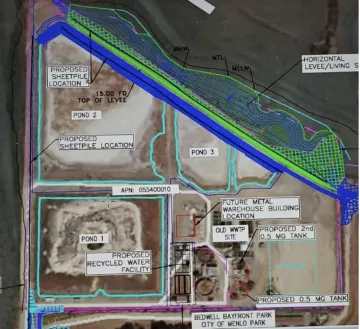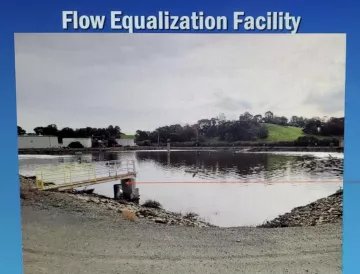April 5, 2023
Bay Conservation and Development Commission
R. Zachary Wasserman, Chair
Rebecca Eisen, Vice Chair
Members of the Commission
Email submittal to PublicComment@bcdc.ca.gov
Cc: Anniken Lyden anniken.lydon@bcdc.ca.gov
RE: 4/06/2023, Agenda Item 11, Public Hearing and Possible Vote on the Flow Equalization and Resource Recovery Facility (FERRF) Levee Improvement Project by West Bay Sanitary District
Dear Chair Wasserman, Vice-Chair Eisen and Members of the Commission, The Sierra Club Loma Prieta Chapter works to ensure sustainable land use while protecting wetlands, open space, wildlife habitat, and other ecological and natural resources in the Bay Area. Our Bay Alive Campaign advocates locally and regionally to preserve and enhance bayland ecosystems and build community resilience to sea level rise.
We are encouraged to note that BCDC is leading development of the Regional Shoreline Adaptation Plan with regional guidelines for sea level rise adaptation, in line with Bay Adapt and Adapting to Rising Tides, that have those very concerns at heart. We would like to see BCDC apply those principles in its project-level decisions. This project is a case in point.
We appreciate the factual detail included in the permit prepared by Staff. We recognize that those recommendations are guided by the regulatory jurisdiction of the Commission, but we respectfully raise the following concerns that would benefit from further consideration.
- The project encroaches and takes Bayland habitat for flood protection purposes.
- At-risk shorelines are the wrong places to build new infrastructure due to predictable impacts of sea level rise (SLR) and potential seismic failures, including liquefaction of bay mud.
- Required redesign of stormwater management may directly conflict with capacity of flow equalization ponds for future extreme storm-related overflow.
- Public outreach omitted two important environmental justice constituencies.
- Plans are insufficient to ensure public access to trails and parking during construction.
1. Encroachment on Public Baylands
We have been following this project for some time and remain concerned that destruction of tidal wetland will occur. We are perplexed by the failure of the West Bay Sanitary District to avoid that wetland destruction due to encroaching into the sloughs and healthy mature wetlands, by instead constructing levees entirely within its own property. Notably, the project’s EIR did not study such an alternative.
2. Investing in Infrastructure for the next 50 years
At-risk shorelines are the wrong places to invest in new infrastructure due to the extraordinary impacts of sea level rise (SLR) and/or predictable seismic failures such as liquefaction of bay mud under levees. State advisories recommend that public monies should no longer be put at risk in such vulnerable areas for these reasons. We are concerned about building costly utility infrastructure that large communities and the Bay ecology will depend on, in areas with high vulnerability to sea level rise and high risk of failure.
3. Land Use, the Revised Stormwater System and Unanticipated Overflow Risk
WBSD, in its applications to BCDC and other regulators, repeatedly stated that ponds within its Bayfront property could not be used for levee placement, nor could they be redesigned to free up land for that purpose. That rationale was used to justify leasing wetlands from the State Lands Commission to extend the outer flank of its levee into the wetland. However, during the regulatory process, WBSD did revise its plan to draw back a portion of that levee along its Pond #3, but not in the section adjoining Pond #2. We are therefore surprised to read the Recommended Permit’s discussion of a revised stormwater management system that would now use the ponds that were previously described as unavailable.


e. The Recommended Permit requires the revised stormwater system. Not having read the Water Board’s 401 Water Quality Certification, we can’t confirm, but assume, that this change was required in it as well and thereby will be part of the permit of the Army Corps of Engineers. We note that the 401 Certification was completed before the winter’s atmospheric river storms ensued and the ponds were needed to contain overflow.
It can be reasonably anticipated that future winter conditions may again include extreme storms that would simultaneously produce sewage overflow and high volume stormwater flow, both directed to the facility ponds. Do the ponds have capacity for both flows? Might such conditions overtop the ponds, flood the site and potentially flow to the Bay? Is that a hazard that this permit would now create?
We ask that BCDC seek further analysis of the revised stormwater system.
4. Public Outreach
The Recommended Permit addresses two community considerations: Environmental Justice and Social Equity, and also stakeholder participation in planning the new public amenity. We believe the discussion would be more effective if it included certain information.
For public outreach, please set standards that provide for robust outreach, coordinating with the City, the Parks department, the Refuge, the FoBBP, and impacted local communities, including publishing notices in the local media, e.g, The Almanac, and other means.
5. Public Access
Bedwell Bayfront Park and its portion of the Bay Trail is heavily used and enjoyed every day of every week. During construction multiple disruptions will impact park users.
Thank you for your consideration.
Sincerely,
Jennifer Chang Hetterly
Bay Alive Campaign Coordinator
Sierra Club Loma Prieta Chapter
Gita Dev, Co -Chair
Sustainable Land Use Committee
Sierra Club Loma Prieta Chapter
Cc James Eggers, Chapter Director, Sierra Club Loma Prieta Chapter
Gladwyn D’Souza, Conservation Chair, Sierra Club Loma Prieta Chapter
Susan DesJardin, Bay Alive Chair, Sierra Club Loma Prieta Chapter
1 FERRF & Recycling Plant DEIR, Appendix A, NOP notification list, pp. 39-46.
2 Staff Recommended Permit, p. 9, Construction Detour